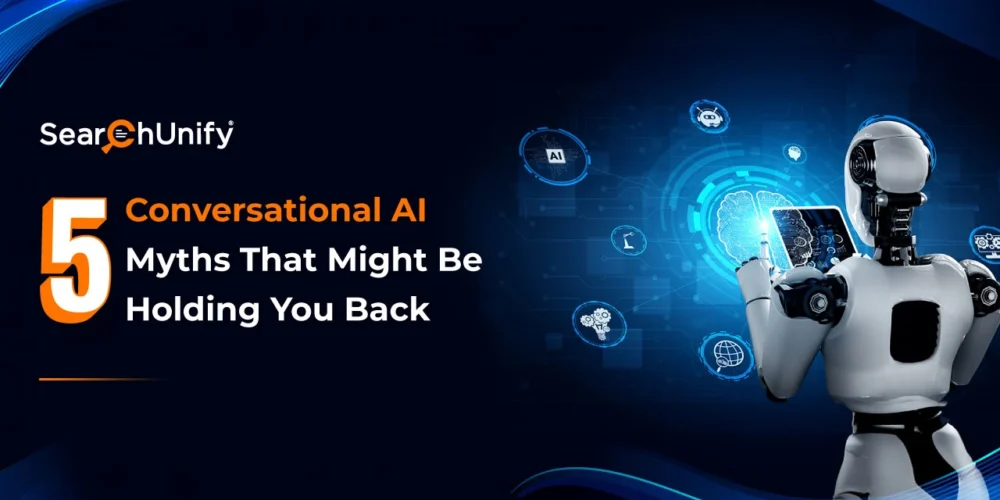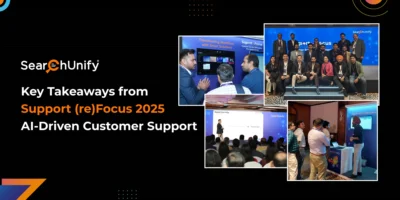
The conversational AI landscape is growing rapidly. In fact, as per Gartner Inc.,” By 2026, conversational artificial intelligence (AI) deployments within contact centers will reduce agent labor costs by $80 billion.”
This means that investing in these solutions leads to cost efficiency. However, some businesses still hesitate to deploy these solutions due to some misconceptions about conversational AI.
In this short article, we are going to debunk all of these myths that will give you a clearer picture!
1. Conversational AI Only Benefits Customer Support
Myth: Many people believe that conversational AI is meant for customer support only and is not applicable to sales, marketing, or other teams.
Reality: While customer support is the major use case of conversational AI, it is not confined to this only. It extends its horizons into Sales, HR, IT support, and so on, where it handles repetitive tasks and automates tasks like lead qualification, employee onboarding, and troubleshooting. This boosts team efficiency and adds to business growth.
Example: Sales can use AI chatbots to engage with website visitors, qualify leads by asking them targeted questions, and book meetings ensuring that sales representatives focus completely on closing deals.
2. All Conversational AI systems are Expensive
Myth: Conversational AI solutions require massive investments and can only be accessible to larger enterprises.
Reality: Earlier AI was expensive but with advancements in cloud computing and AI-as-a-service models these conversational AI systems have become affordable for all sizes of businesses. Additionally, many platforms are offering tiered pricing models that help organizations scale their AI capabilities as per their needs.
Example: A small business can invest in AI-powered chatbots by paying per interaction rather than paying licensing fees. The deployment of these AI-powered chatbots will reduce their additional support agent costs.
3. AI can’t Handle Complex Queries
Myth: AI-powered chatbots are only meant for handling simple queries and rely on pre-defined responses. They fail when it comes to multi-step queries.
Reality: AI-powered chatbots are no longer confined to pre-defined scripted responses. They can now understand the natural human language and can interpret the context and intent of the queries with technologies like natural language processing and large language models.
Example: A Conversational AI system in customer support can handle technical troubleshooting by analyzing symptoms, suggesting fixes, and escalating when needed. AI assistants in healthcare can assess symptoms and provide preliminary guidance before scheduling patients’ appointments with doctors.
4. Implementation is Complicated
Myth: Deploying conversational AI systems requires technical expertise, long development cycles, and high maintenance costs.
Reality: Modern-day conversational AI solutions have made this easier with low-code or no-code AI assistants, and seamless integrations. Instead of months, deploying AI chatbots takes days or a week.
Example: A customer support team can integrate a chatbot with Slack, Microsoft Teams, or CRM platforms like Salesforce without requiring developers. With intuitive drag-and-drop interfaces, businesses can build AI assistants without coding.
5. Conversational AI Lacks Emotional Intelligence
Myth: AI is unable to recognize human sentiment and understand the tone thus, it lacks emotional intelligence leading to customer frustration.
Reality: AI-powered chatbots are capable of understanding customer sentiment through sentiment analysis. They can also understand the context and intent behind a user’s search query through contextual understanding.
Example: AI chatbots recognize customer frustration through language cues, then they adjust their tone of responses and hand off the case to a live agent to prevent escalations. Thus, lowering the resolution times.
Conclusion
Conversational AI is no longer a futuristic concept it is redefining the support landscape. At the rate it is evolving, it will soon bridge the gap between humans and AI.
Don’t let some misconceptions stop you from achieving excellence!
Are you ready to redefine your support operations?
Presenting you SUVA, an Agentic AI-powered virtual assistant that delivers fine-tuned, contextual, intent-driven conversational experiences.
Thinking about if it is the right choice or not? Don’t worry!
Request a Demo and decide for yourself!











